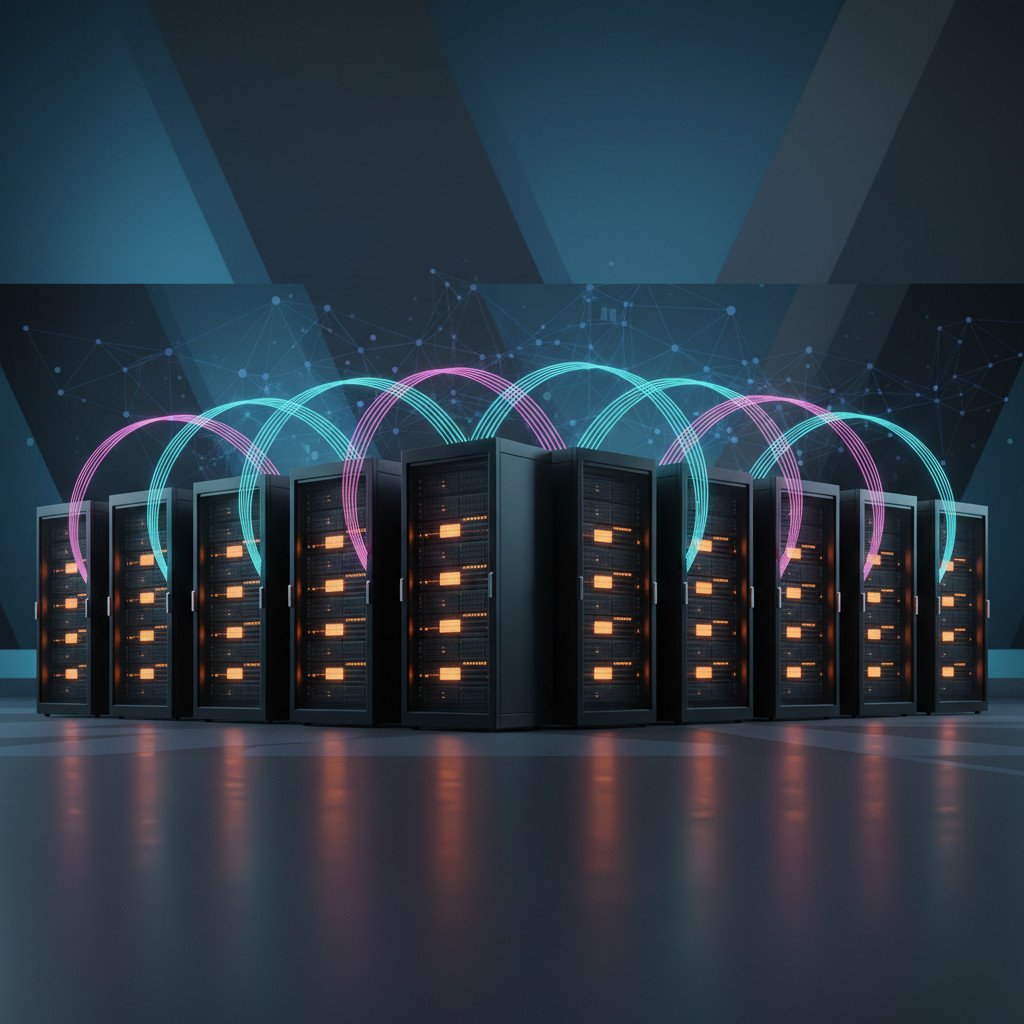AI data center infrastructure is the backbone of modern machine learning at scale. Today, it connects GPUs, storage, networking, and power into resilient systems that train trillion-parameter models. Because model size and data volume grow fast, infrastructure choices determine speed, cost, and feasibility.
Leaders like NVIDIA, Oracle, Cisco, and Meta redesign both hardware and software for this era. Spectrum-X Ethernet, MGX racks, NVLink, and high-voltage power design are practical levers. Moreover, new architectures link multiple sites into unified AI factories, which boosts throughput and lowers latency. As a result, enterprises can scale training and inference more predictably.
This article examines chip strategies, networking advances, and data platform integrations. Specifically, we will unpack Vera Rubin plans, Spectrum-X throughput claims, and Oracle AI Database 26ai features. Therefore, readers will gain actionable guidance for designing resilient, cost efficient AI data centers and reducing infrastructure debt. Finally, the article balances technical depth with vendor insights so you can make informed architecture decisions.

Key Components of AI Data Center Infrastructure
AI data center infrastructure brings together compute, networking, storage, and facility systems. Because AI workloads demand extreme throughput and low latency, each layer requires redesign and optimisation. Below we break down the essential components, and we show practical examples and vendor-led approaches.
Core compute and AI hardware
- GPUs and accelerators: Modern systems rely on high-density GPUs and AI accelerators for training and inference. For example, NVIDIA H100 and similar accelerators deliver dense AI compute power and tensor throughput. Moreover, NVLink and GPU-to-GPU fabric support scale-up inside racks.
- CPU and memory: Servers still use fast CPUs and large memory pools for preprocessing, orchestration, and model serving. Therefore, pick server platforms that balance single-threaded tasks with GPU I O.
- Rack systems and MGX style designs: MGX racks combine compute and switching to enable both scale-up and scale-out. As a result, MGX-style modularity shortens time to market for new AI workloads.
- SuperNICs and storage accelerators: Offloading networking and storage tasks with SmartNICs or SuperNICs reduces CPU overhead and improves throughput.
Networking and data center optimisation
- High-throughput Ethernet and Spectrum-X: AI needs near-line-rate interconnects. Spectrum-X promises up to 95 percent effective bandwidth for AI traffic, which helps large-scale training across clusters. However, achieving that throughput requires tuned OS and fabrics.
- Open networking and DCI: Use open NOS options like SONiC or FBOSS to avoid vendor lock-in. For enterprise readiness and orchestration guidance, see Cisco AI Readiness DCI and learn how interconnect strategy matters.
- Topology and dark fibre: Design for low-latency fabrics and multi-site links using dark fibre or MGX interconnects to create unified AI data centre systems.
Power, cooling, and facility considerations
- High-voltage power delivery: Transitioning to 800 volt DC reduces heat loss and improves efficiency, with power-smoothing tech lowering spikes by up to 30 percent.
- Cooling and thermal design: Use direct liquid cooling, rear-door heat exchangers, and hot-aisle containment to manage GPU heat density.
- Observability and optimisation: Monitor PUE, rack inlet temperatures, and power spikes. For enterprise AI rollout patterns and governance, refer to Enterprise AI Infrastructure Models which covers deployment scale and reliability.
Practical note: align compute selection with data platform needs. For agentic AI and ROI considerations, review Agentic AI ROI Governance before committing to long-term infrastructure.
| Aspect | Traditional Data Center Infrastructure | AI Data Center Infrastructure | Improvement and Impact |
|---|---|---|---|
| Performance | Built for general workloads and transactional systems. CPUs handle most processing. | Engineered for parallel compute with dense GPUs and AI accelerators. NVLink and SuperNICs improve local throughput. | Therefore, AI tasks run with far greater throughput and shorter training times. |
| Scalability | Scales by adding servers and storage. Network and I O limit growth. | Scales with MGX-style racks, Spectrum-X fabrics, and multi-site links using dark fibre. | As a result, enterprises can scale training across regions with lower latency. |
| Cooling technologies | Relies on air cooling, raised floors, and hot-aisle containment. | Uses direct liquid cooling, rear-door heat exchangers, and high-density thermal designs. | These methods manage GPU heat density and enable higher rack power. |
| Energy consumption | Multiple AC conversions cause higher losses and waste heat. Power spikes are common. | 800 volt DC power delivery and power-smoothing tech reduce losses and spikes by up to 30 percent. | Consequently, PUE improves and operational energy costs decline. |
| Cost efficiency | Lower initial complexity but rising TCO for large ML workloads due to slow runs. | Higher capital expenditure yet lower cost per training run thanks to density and throughput gains. | Therefore, TCO often improves for sustained AI workloads. |
| Network throughput | Standard Ethernet often delivers limited effective bandwidth for AI traffic. | Spectrum-X and SuperNICs offer up to 95 percent effective bandwidth for AI workloads. | This reduces synchronization stalls and speeds distributed training. |
| Hardware specialization | General-purpose servers and commodity storage arrays. | GPU-heavy servers, NVLink fabrics, SuperNICs, and optimized storage for tensor data. | As a result, utilization and model throughput increase significantly. |
Benefits of AI data center infrastructure
AI data center infrastructure delivers dramatic performance gains for training and inference. For example, Spectrum-X and SuperNICs can push effective bandwidth toward 95 percent, while standard Ethernet often sits near 60 percent. As a result, distributed training sees fewer synchronization stalls and faster epoch times. Moreover, MGX racks and NVLink enable scale-up and scale-out modes. Therefore, organizations can run larger models locally and across sites.
Key benefits include:
- Higher throughput and lower latency. This reduces training time and speeds model iteration.
- Better cost per training run. Despite higher capital spending, density and efficiency lower long term TCO.
- Energy efficiencies from design changes. For instance, 800 volt DC power delivery lowers heat loss and, with power smoothing, cuts spikes by up to 30 percent.
- New cooling approaches. Direct liquid cooling lets racks operate at higher power densities without thermal throttling.
- Faster innovation. Integrated platforms like Oracle AI Database 26ai and OCI GPU options bring model-serving closer to data, which shortens development cycles.
Challenges
However, building and operating AI data center infrastructure presents major hurdles. First, upfront costs remain high. Buying dense GPUs, racks, and advanced switches requires large capital. Second, power and cooling complexity increases. High-density racks demand liquid cooling and advanced power delivery, which require specialist skills.
Additional challenges include:
- Interoperability and vendor lock-in. Open networking mitigates this, but multi-vendor stacks still need careful integration.
- Supply chain and deployment lead times. GPUs and specialized components often face long lead times.
- Software and orchestration maturity. Distributed training needs tuned stacks and proven orchestration tools to run reliably at scale.
- Governance and security. As AI moves into the data layer, teams must secure models and data while maintaining compliance.
In short, AI data center infrastructure unlocks scale and speed. Yet, it calls for new skills, higher upfront investment, and tighter operational discipline. With planning and governance, enterprises can balance gains against these challenges and build sustainable AI platforms.
Conclusion
AI data center infrastructure is now a strategic asset for any organization pursuing serious AI. The right mix of GPUs, accelerators, networking, storage, and power systems cuts training time and raises throughput. Moreover, features like Spectrum-X fabrics and MGX racks enable multi-site scaling and better utilization. However, these gains come with tradeoffs: higher upfront costs, cooling complexity, and integration work. Therefore, teams must plan for power delivery, liquid cooling, orchestration, and governance. As a result, you can lower cost per training run and accelerate model iteration while managing operational risk.
EMP0 (Employee Number Zero, LLC) helps companies translate infrastructure into business outcomes. They specialise in AI and automation solutions with a focus on sales and marketing automation. EMP0 advises on secure deployment, compliance, and ROI for AI workloads. In addition, they build workflows that connect data platforms to model serving, which speeds adoption and protects sensitive data. For teams that need practical guidance, EMP0 combines technical depth with productised automation to help businesses scale AI responsibly.
Frequently Asked Questions (FAQs)
What is AI data center infrastructure?
AI data center infrastructure refers to purpose built systems that support large scale machine learning and inference. It combines dense GPUs, high throughput networking, optimized storage, and specialized power and cooling. Because these components work together, they speed model training and reduce latency.
How does AI infrastructure differ from traditional data centers?
AI centers use GPU heavy servers, NVLink fabrics, SuperNICs, and MGX style racks. Traditional centers favor CPU centric servers and general storage. As a result, AI deployments achieve higher throughput and better cost per training run for sustained workloads.
What cooling and power strategies are critical?
Direct liquid cooling, rear door heat exchangers, and hot aisle containment manage dense GPU heat. Moreover, 800 volt DC power delivery and power smoothing reduce conversion losses and spikes by up to 30 percent. Therefore, these strategies improve PUE and reliability.
How do networking advances like Spectrum-X help?
Spectrum-X and SuperNICs boost effective bandwidth toward 95 percent for AI traffic. For example, this reduces synchronization stalls during distributed training. Consequently, clusters scale more efficiently across racks and sites.
How should businesses plan deployment and control costs?
Start with workload profiling and a phased rollout. Use hybrid cloud and OCI GPU options for burst capacity. Also, invest in orchestration and governance to protect data and control operational risk. Finally, balance capital costs against lower cost per training run over time.

